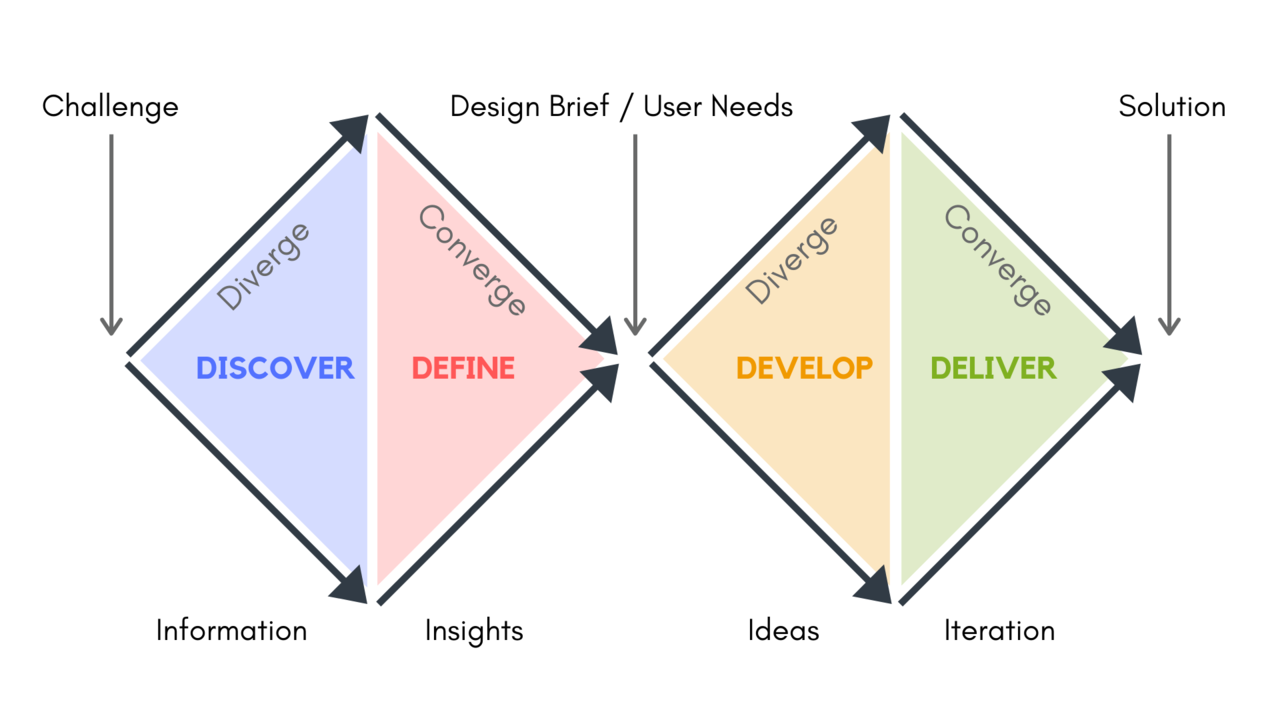
Legal Design Explained: Part 3 - How do we do legal design?
In this third article of my four-part series, we'll look at the various tools, methods and principles involved in legal design - the thought processes and building blocks used in a legal design project.
Divergent and Convergent Thinking
A legal design project usually follows a flow of “divergent thinking” and “convergent thinking”:
- Divergent thinking is the ability to generate many ideas or solutions from a single idea or piece of information. Divergent thinking is vital to creative thinking.
- Convergent thinking is the ability to take many pieces of information or data and generate one solution. We practice convergent thinking a lot in our everyday lives, sifting through large amounts of information to make decisions.
In a legal design project, combining both types of thinking allows us to get down to the essence of the challenge that needs to be tackled, before addressing that challenge with ideas and solutions. It is vitally important to use both types of thinking. First, we go wide, using divergent thinking to be able to take in lots of information or brainstorm lots of ideas. Then we go narrow, using convergent thinking to focus our thoughts and come up with concise summaries or ideas. The image below (often called the ‘double diamond’) shows the basic framework for a legal design project. In reality the process isn’t usually this clean and we may go back and forth between the stages depending on how the project evolves.
Empathy and Understanding the Problem
We always put the user at the heart of the design – everything is centred around what we learn about the user’s needs and problems. We use empathy to put ourselves in the shoes of the user and really try to understand their perspective.
To get to the right solution, you need to know the real problem. In a legal design project, we work to understand the problems and requirements of the users before designing anything. If we jump straight to developing a solution, without properly understanding the user’s experience, we end up with a pretty design that doesn’t meet the needs of our users and has wasted valuable time and resources.
Multi-Skilled Team
Your legal design project team needs to be multi-skilled. Collaborating with a diverse group of people, with a range of skills, is crucial for developing the best solutions. Generally, we need some people specialising in specific fields (like technology, people, psychology, design, law) and, crucially, some representing the users.
Visualisation
The way information is visually presented is essential to how well we absorb and understand that information. Visualisation is a vital component of not only the legal design solution but also the legal design process.
- Process: When conducting a legal design project, we work on the principle of “show me, don’t tell me”. This means that there is loads of drawing, acting and scribbling on post-it notes!
- Solution: The solutions we develop usually incorporate visualisation – diagrams, icons, images, drawings, timelines, flows, layout – the list goes on. Many of us respond to visualisations better than written text – visualisation can be a powerful way to communicate information in a universal and instantly-understandable way.
Plain Language
We try to use plain, uncomplicated language! This is sometimes difficult when conveying legal concepts, which, in themselves, are often words not used in the everyday life – think of words like ‘conveyancing’, ‘litigation’, ‘jurisdiction’, ‘torts’, for example. But it’s important to move away from unnecessary “legalese” – if we can say something in plain language that is universally understandable, we should. Why do we, as lawyers, so often insist on over-complicating sentences and confusing the reader by reverting to lengthy paragraphs with unusual words (think ‘notwithstanding’) that no ordinary person would say in everyday life?
Technology
Technology can really enhance legal design solutions, making them interactive and digitally accessible. Technology is not always necessary, however. Despite the common misconception, technology is not innovation, but technology can certainly enable innovation. After considering your users’ preferences and goals, you might decide that a non-technological solution would be the most effective one. In legal design, it’s just as important to recognise when technology is not the best solution, despite its hype and promises.
Originally published by the Society of Computers & Law https://www.scl.org/articles/10517-legal-design-explained-part-3-how-do-we-do-legal-design
Read the full series:
- Part 1 - What is Legal Design?
- Part 2 - Why do we do Legal Design?
- Part 3 - How do we do Legal Design?
- Part 4 - What does Legal Design look like?



SAFe SPC 5.1 | Digital Transformation | Corporate Innovation | Innovation driven Transformation | Agile Methodologies
4yBem bom!